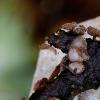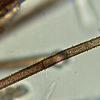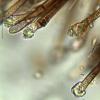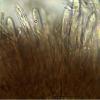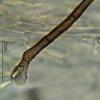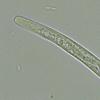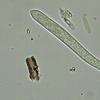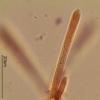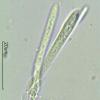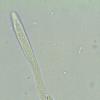
20-06-2013 22:49
 Rubén Martínez-Gil
Rubén Martínez-Gil
Hola, de nuevo.Sobre ramitas y hojas de Quercus il

20-06-2013 19:47
 Rubén Martínez-Gil
Rubén Martínez-Gil
Hola a todos.Pongo unas fotos de una especie que h

18-06-2013 17:43
Hi all!I have been found this specie in cow dung i

20-06-2013 17:04
 Jean-Paul Priou
Jean-Paul Priou
Quelqu'un ou quelqu'une a le papier suivant ? Than

19-06-2013 11:24
Marja PennanenHello forum,I found some pinkish ascos on Luzula m
Brunnipila fuscescens?
Rubén Martínez-Gil,
20-06-2013 22:49
 Hola, de nuevo.
Hola, de nuevo.Sobre ramitas y hojas de Quercus ilex a 1200 msnm
Ascomas de hasta 1,5 mm y esporas 8-12 x 1,5-2,5 micras.
¿qué diferencias hay con B. clandestina? Hábitat? Tamaño esporal?
Gracias por vuestra ayuda.
Un saludo
Rubén
Hans-Otto Baral,
21-06-2013 07:54

Re : Brunnipila fuscescens?
Would be important to look for the croziers. B. clandestina without, B. fuscescens and B. calyculiformis with croziers, the latter with longer hairs.
Take care also whether there might be a difference between leaves and twigs. So please measure the hair length. Spore length speaks for calyculiformis.
Take care also whether there might be a difference between leaves and twigs. So please measure the hair length. Spore length speaks for calyculiformis.
Rubén Martínez-Gil,
21-06-2013 09:01

Re : Brunnipila fuscescens?
Hola a todos.
Gracias por sus respuestas Zotto.
Creo que no tiene croziers, pomgo fotos de ascas de ayer, hoy miraré un poco más para sacar mejor imágenes.
Pelos tienen medida de menos de 200 micras. Luego también mido más.
Sólo tengo muestra de ejemplares de ramitas, los de hojas no traje a casa, es una pena.
Gracias por todo.
Rubén
Gracias por sus respuestas Zotto.
Creo que no tiene croziers, pomgo fotos de ascas de ayer, hoy miraré un poco más para sacar mejor imágenes.
Pelos tienen medida de menos de 200 micras. Luego también mido más.
Sólo tengo muestra de ejemplares de ramitas, los de hojas no traje a casa, es una pena.
Gracias por todo.
Rubén
Hans-Otto Baral,
21-06-2013 09:05

Re : Brunnipila fuscescens?
Hola Ruben
with detached asci alone it is almost impossible to be sure. best are young asci that are still attached to the basal hyphae. I know it is not easy. Either a section of living tissue is good, or a strong sqash mount, perhaps by using Congo Red.
Zotto
with detached asci alone it is almost impossible to be sure. best are young asci that are still attached to the basal hyphae. I know it is not easy. Either a section of living tissue is good, or a strong sqash mount, perhaps by using Congo Red.
Zotto
Rubén Martínez-Gil,
21-06-2013 11:12
Hans-Otto Baral,
21-06-2013 11:32

Re : Brunnipila fuscescens?
With 150-175 µm only calyculiformis comes into consideration. On one photo I think I see a crozier (the fourth pic, at the lowermost end). But no, the other pics clearly show simple septa.
I never saw this species on leaves. Maybe coriaceous leaves are good for it? Often it grew on Corylus. but also Alnus, Acer etc.
But without croziers it cannot be B. calyculiformis as I understand this species. Perhaps a new taxon...
Zotto
I never saw this species on leaves. Maybe coriaceous leaves are good for it? Often it grew on Corylus. but also Alnus, Acer etc.
But without croziers it cannot be B. calyculiformis as I understand this species. Perhaps a new taxon...
Zotto
Rubén Martínez-Gil,
21-06-2013 15:02

Re : Brunnipila fuscescens?
Gracias por todo Zotto.
Esperaremos a encontrar más colecciones.
Un saludo
Rubén
Esperaremos a encontrar más colecciones.
Un saludo
Rubén

